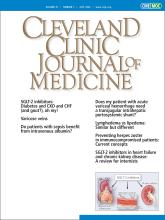Article Figures & Data
Tables
Complications Comment Postherpetic neuralgia Most common complication of herpes zoster
Manifests as persistent pain beyond 90 days of rashHerpes zoster ophthalmicus Vision-threatening complication from involvement of ophthalmic division of cranial nerve V
High risk of vision loss if antiviral therapy is not promptly initiatedAcute retinal necrosis Necrotic infection of the retina that often leads to profound vision loss
Caused by herpes viruses, most often by herpes zoster or varicellaRamsay Hunt syndrome (herpes zoster oticus) Major otologic complication of herpes zoster from viral reactivation within the geniculate ganglion, with potential spread to cranial nerves V, VII, VIII, IX, and X
Often manifests as the triad of facial palsy, ear pain, and otic vesicular lesionsMiscellaneous neurologic complications Stroke syndromes, motor neuropathy, myelitis, encephalitis, central nervous system vasculitis Disseminated infection Disseminated varicella infection with potential for visceral target organ involvement with possible widespread cutaneous involvement Based on information from references 1 and 2.
- TABLE 2
Patient groups identified as immunocompromised by the Centers for Disease Control and Prevention
Patients with primary immunodeficiency states Patients with hematopoietic stem cell transplant Patients with solid-organ transplant Patients with malignancies Patients living with human immunodeficiency virus infection Patients with immune-mediated disease states Patients taking immunosuppressive medications Based on information from reference 12.
- TABLE 3
Summary of recommendations for recombinant zoster vaccine in immunocompromised groups
Group (recommendation source) Recommendations Hematopoietic transplantation
(CDC)23Autologous: wait at least 3 months after transplant
Allogeneic: wait at least 6 months after transplant
Initiate RZV about 2 months before discontinuation of antiviral therapyaSolid-organ transplantation
(CDC)23Administer RZV prior to transplant (if possible) or 6–12 months after transplant when graft stable on maintenance immunosuppressiona Malignancy
(CDC)23Administer RZV before to treatment (if possible) or when the immune system is not acutely suppressed or is likely to be most robusta Rheumatic inflammatory and musculoskeletal diseases
(American College of Rheumatology)24Administering RZV is strongly recommended for patients with rheumatic and musculoskeletal diseases age > 18 who are taking immunosuppressive medication Inflammatory bowel disease
(American College of Rheumatology)24All patients receiving Janus kinase inhibitor therapy should receive RZV
Risk of herpes zoster should be considered with combinations of other immunosuppressiveb therapiesPsoriasis
(Medical Board of the National Psoriasis Foundation)25RZV should be given to all patients with psoriasis and psoriatic arthritis > age 50 and to patients < age 50 on tofacitinib, systemic corticosteroids, or combination systemic therapyb Primary immunodeficiency diseases No formal recommendations from societies as of now; per package insert RZV is indicated in adults age 18 and older who are or will be at increased risk of herpes zoster due to immunodeficiency or immunosuppression caused by known disease26 HIV
(CDC)27Patients with HIV ≥ age 18 should receive 2 doses of RZV at 0 and 2 to 6 months
Consider delaying vaccination until the patient is virologically suppressed on antiretroviral therapy or until the CD4 count is > 200 cells/mm3 to ensure a robust vaccine response
Patients with HIV ≥ age 18 should receive RZV regardless of previous history of herpes zoster or previous receipt of live zoster vaccine (no longer available) or therapy↵a Recommendations vary somewhat among societies; expert opinion was recently summarized.28
↵b Systemic immunosuppression refers to current treatment with prednisone (> 20 mg/day for more than 14 days), azathioprine (> 2.5 mg/kg/day), mercaptopurine (> 1.5 mg/kg/day), methotrexate (> 0.4 mg/kg/week), cyclosporine, tacrolimus, infliximab, adalimumab, golimumab, certolizumab, ustekinumab, or tofacitinib.
CDC = Centers for Disease Control and Prevention; HIV = human immunodeficiency virus; RZV = recombinant zoster vaccine






